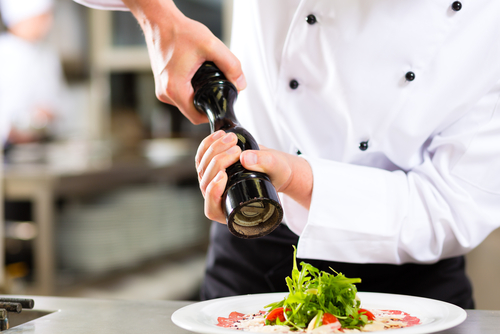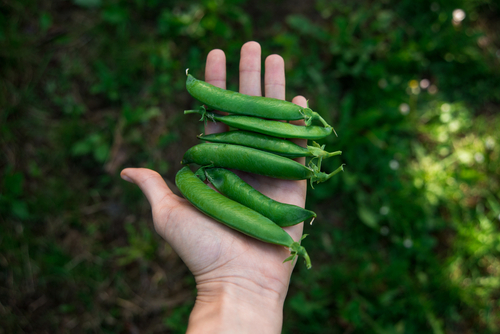How important is it to calculate cost of goods sold for restaurants? We argue, very. Cost of goods sold (CoGS) is one of the most important metrics for a restaurant to keep track of.
It ties into your restaurant’s menu engineering efforts (i.e: how you price menu items and lay them out in your menu to manufacture more sales), your profit margins, and your inventory management (i.e: the inventory counts you perform at the beginning and end of each day).
And ultimately, you maximize your revenue when you strike the perfect balance between cost of goods sold and total revenue from food sales.
Chances are that if you’re reading this, you already know that CoGS is important, but aren’t quite sure what it is or how to find it. Well, you’re in the right place!
In this article, you’ll learn everything you need to know about restaurant CoGS:
• What is an ideal cost of goods sold?
• How to calculate cost of goods sold
• How to lower cost of goods sold

What is cost of goods sold for restaurants?
Cost of goods sold (CoGS) is the sum of the total ingredients and other expenses that go into making a dish. For example, if you serve a pizza, your cost of goods sold would include the cheese, dough, sauce, other condiments, dipping sauces, packaging (if it’s for meal delivery) — right down to the napkins.
Unlike food costs, CoGS is the total costs associated with a dish, rather than exclusively the food ingredients.
While each restaurant’s cost of goods sold varies from one restaurant to another, typically one-third of a restaurant's gross revenue goes towards paying for CoGS. However, your CoGS is not a fixed expense.
As the cost of food inventory and supplies changes, whether it’s a result of inflation or seasonality, so will your cost of goods sold. This is why CoGS is considered a variable expense.
With variable expenses, especially one as central to your business’s finances as CoGS, we recommend monitoring it every week and assuring that the price you’re charging for menu items leaves you with enough gross profits once all fixed, variable and mixed expenses are subtracted.
Adjust menu prices to compensate for your expenses, including CoGS, and assure you’re not leaving any profits on the table.
What is an ideal cost of goods sold for restaurants?
Similar to food costs, there is no ideal cost of goods sold, as it depends on the type of food you serve, your other restaurant expenses, and your menu pricing.
With that said, the Food Service Warehouse recommends that a restaurant’s cost of goods sold account for no more than 31% of total sales.
The lower your CoGS percentage, the higher your margins. And in turn, profitability.
When you look at your restaurant’s current CoGS, we recommend thinking of what we like to call the “golden ratio’ — that is, the gross profit per menu item in relation to its CoGS.
For example, let’s say you’re an Italian restaurant with an extensive wine program. Would you rather buy a $40 bottle of wine and sell it for $100 (40% CoGS percentage), or a $75 bottle that you sell for $200 (37.5% CoGS percentage)?
While one bottle is costing you more upfront, you stand to make more gross profit from selling it. Keeping a keen eye on your CoGS per menu item can help your restaurant rake in as many profits per sale as possible.
And in an industry with notoriously low profit margins (between 3% and 9% depending on restaurant type), every dollar in your pocket makes a difference.
How to calculate cost of goods sold for restaurants
Now, you’re probably wondering how to find your cost of goods sold. Before you start calculating CoGS for a certain period (weekly, monthly, annual), you need these three values:
• Beginning inventory
• Purchased inventory
• Ending inventory
Beginning inventory
Beginning inventory refers to the monetary value of the food inventory leftover from the previous period.
For example, if you bought 20 bags of lemons last month at $2 per bag, and this month you have 8 bags leftover, your beginning inventory value for lemons is $16.
Purchased inventory
Purchased inventory refers to the monetary value of the food inventory you bought for the current period.
Continuing with the lemon example, let’s say you bought 12 bags of lemons to bring your overall inventory level back to 20. In this example, your purchase inventory value is $24.
Ending inventory
Ending inventory refers to the monetary value of the inventory that you have left at the end of the period.
For example, let’s say of those 20 bags of lemons, you have 3 left over at the end of the week. The value of your ending inventory is $9.
Cost of goods sold formula
Once you find the above values, you’re ready to calculate your cost of goods sold using this formula.
An example of cost of goods sold for restaurants
Picture yourself as the owner of a pizza parlour in downtown New York. You want to calculate your cost of goods sold for February (fun fact: February 9 is national pizza day!). You had $6,500 worth of beginning inventory and purchased $5,000 worth of food inventory that month. You ended the month of February with just $100 in inventory.
Beginning inventory = $1,500
Purchased inventory = $5,000
Ending inventory = $100
With those values, you can find your cost of goods sold.
Cost of goods sold = (6,500 - 5,000) - 100
Cost of goods sold = (1,500) - 100
Cost of goods sold = 1,400
After a quick calculation, you have successfully identified your CoGS for February. You spent $1,400 on food inventory, packaging, and everything else that figures into your food sales.

What cost of goods sold means for your restaurant
Cost of goods sold is one of the most critical metrics for you to monitor, as it relates directly to your revenue, gross profits, and, of course, your inventory management.
Whether you track your cost of goods sold in a simple spreadsheet or use a software program, the important thing is that you do it. Tracking and analyzing this critical data is the key to improving efficiency and increasing profitability in your business. It allows you to plan for the future.
Generally speaking, fine dining establishments have a higher cost of goods sold than fast-casual restaurants. And typically, the higher a restaurant’s cost of goods sold is, the higher their menu prices will be to compensate.
Remember, the lower your CoGS is, the larger the profit margin is on each sale. However, having a low cost of goods sold is not universally a positive omen. If a restaurant’s CoGS is $0, that also means it sold nothing.
CoGS is a balancing act. A restaurateur’s job is to sell a predictable volume of food, and allocate a small enough portion of that revenue to CoGS and food inventory. Lowering CoGS without impacting food quality is the true challenge.
How to keep your restaurant’s CoGS low
The lower your cost of goods sold is, typically the higher your restaurant’s profit margins are. Let’s explore some ways you can bring your CoGS down and maximize your profits.
Closely monitor your sell-through rate
The most surefire way to keep your cost of goods sold low is to assure that you’re only buying as much food inventory as you sell-through for a given period.
Your restaurant POS system should have reports that give you insight into how much of each menu item you sell over a given period. The trick is to project how much food inventory you need to support average demand for each menu item -- no more, no less. This assures that you aren’t wasting money on food inventory that you ultimately will not use (or worse, it spoils before you can use it. But more on food waste later).
Additionally, it’s important to get serious about food inventory management. Establish clear guidelines on portion sizes, you may be losing money each day as a result of over-portioning, food waste, and, in some unfortunate cases, employee theft. Each can contribute to higher-than-necessary CoGS without bringing in revenue. Prioritize inventory management to avoid any unnecessary net losses.
Buy food inventory and supplies in bulk
Another tactic to consider is to purchase your food inventory in bulk to lower your overall costs. Some vendors offer discount pricing for restaurants that purchase greater volumes (or sign on for a long-term agreement).
We recommend purchasing in bulk for food inventory that is either non-perishable (that is, food that does not spoil quickly, such as canned tomato sauce), or inventory that your restaurant sells through at an expedited rate (like cheese at a pizzeria). Typically, you can purchase these items in bulk without fear of them spoiling before you get a chance to use them.
That said, only purchase as much food inventory for a given period as you can start and sell. Otherwise, you run the risk of being left with spoiled, unsalvageable inventory.
Spend less on food inventory
Typically, you should avoid spending less on food inventory if at all possible. Why? Because when you spend less on your food inventory, you may compromise the quality of the dishes you serve. If patrons feel like the food you serve is no longer worth what you charge, you’ll be left with a few options: either you lower your prices (not good), or switch back to the original inventory (which brings you back to square one). Even worse, you run the risk of losing your customers’ trust, which is difficult to earn back.
We suggest shopping around when it comes to food inventory. Talk to various suppliers and see if some can offer you better prices than others.
Like with most businesses, some suppliers specialize in a specific type of food inventory. One vendor may be able to supply you with inventory at a fraction of the price of others.
Likewise, if you notice that one supplier offers better prices than yours, consider opening up a dialogue with them. Most suppliers would prefer offering you a preferential rate than losing your business entirely.
Tackle food waste
Food waste is a big concern for restaurateurs. The reality is, regardless of how accurately you monitor sell-through and how methodical you are at purchasing inventory, eventually you will need to deal with food inventory that is on the verge of going off.
If, when you perform your weekly inventory count, you notice that some ingredients are close to spoiling (but still safe to eat), give your chefs the green light to get creative and concoct a new special! Make a delicious vegetable stock or soup with ageing produce. Or try creating fresh-pressed juices with fruit that’s past its prime. Bread that’s too old to serve as an entree can be switched up as french toast.
There are plenty of ways to reuse food on the verge of spoiling. Embrace that inevitability and allow your chefs to flex their creative muscles.
Use seasonal ingredients in your menu
Another roundabout way to lower your cost of goods sold is to use seasonal, locally-sourced ingredients, which tend to be less expensive than imported goods. Seasonal pricing can be your secret weapon for lowering what you spend on food inventory, while simultaneously serving up great, fresh food.
Not only does it keep your menu fresh and interesting, it’s also what consumers want more and more of these days, as the world increasingly turns its attention to environmental issues.
Just remember, seasonal food is typically fresh produce. Pay attention to your sell-through rate and manage your inventory levels accordingly to prevent food waste.

Reconfigure your menu to boost sales
The layout of both your online and dine-in menus has a huge impact on which dishes patrons order. And, believe it or not, menu engineering in itself is a profession! Luckily, online ordering platforms like Flipdish make it easy for you to change the layout and order of menu items to optimize sales.
Review your menu descriptions, photos, and of course, the order in which you present your menu items online. Draw attention to menu items with high profit margins to increase the return on your CoGS.
The restaurateur’s guide to cost of goods sold
Balancing your food quality, cost of goods sold, and sales requires diligent inventory management, sales forecasting, and menu pricing.
While managing CoGS requires a lot of careful attention and regular fine-tuning, with the right processes (inventory counts, sales forecasting, and adjusting menu prices) and consistency, you can stay on top of it and set your restaurant up to maximize its profits.


